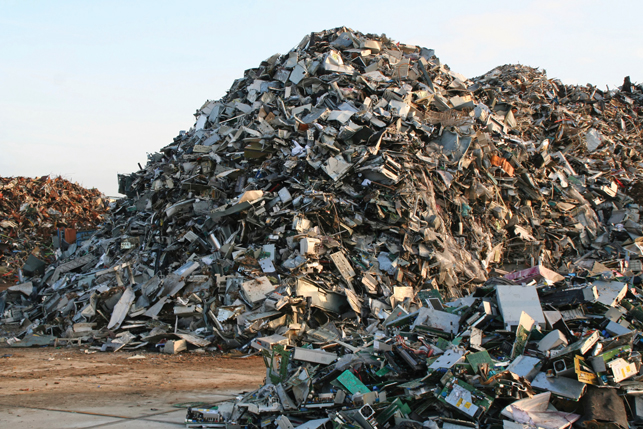Carl Alviani caught up with Sarah Krasley and Dawn Danby, Autodesk’s resident sustainability experts, to talk about efficiency, recyclability and energy footprint, and to put the company’s sustainability credentials under the spotlight
What’s a modern product designer to do? Constraints are something to which we’ve long been resigned, and have been since the early days – cost constraints, strength and weight constraints, whether the boss has a thing for stainless steel or hates snap fits. But as a rule, any limitation or consideration in a product development effort has some sort of precedent, and a range of software tools already dedicated to accommodating it.

This is where sustainability throws a lot of us for a loop. Not that designing a product to minimize its environmental impact is an insurmountable task; when you get down to it, sustainability is really just another set of constraints, and an exceptionally justifiable one at that. The problem is more one of unfamiliarity, both in the types of considerations that need to be made, and the tools available to tackle them. It’s one thing to be faced with an extra-complicated venting problem and have to max out your expertise in grill design, but quite another to be told “We need a carbon footprint and water usage reduction of 30% in this one.” Unless you recently graduated from an unusually forward-thinking school, this is about as familiar a request as being asked to design an edible car.
Such requests are exactly what product designers are getting more of, though, and there is every reason to believe they’ll get a lot more common in the next few years. With strengthening environmental regulations and growing corporate and consumer awareness of sustainability, companies are turning green at an ever-increasing rate.
Fortunately, help is on the way. CAD software providers have been falling over themselves to accommodate this newly expanded need, and you could even say there’s a small scale fight to see who will take the crown as the CAD provider that lets designers go green the most rapidly and easily. Or at least lead the way for the rest of the industry.
A contender to the throne?
Autodesk has made much marketing noise over the past few years about sustainability, from bragging about its own sustainable practices, to releasing numerous plug-ins and software packages to specifically enable green building, to creating several internal positions whose sole job is to encourage and develop these capabilities. Sarah Krasley and Dawn Danby hold two of those positions – Sarah heads up sustainability solutions for Autodesk’s manufacturing group, including Inventor and its brethren, and Dawn manages the Sustainable Design Program. Both were kind enough to chat with us last month about what they’re offering product designers in an age of increasing attention on efficiency, recyclability and energy footprint.
What’s immediately apparent in the conversation is how much Autodesk’s approach to sustainable design for product design differs from its approach in the building industry. Architects, civil engineers and construction managers have received some very focused solutions to help with sustainable practices in the past few years (see Green Building Studio and Rapid Energy Modelling, for starters), but on first glance there’s precious little available in the product world. The disparity, explains Danby, is no oversight. “Somewhere between 40 and 48 percent of global carbon emissions come from constructing and operating buildings,” she points out, noting that the complexity of systems in a large construction project is so high that specialised tools have become requisite.

Dawn Danby manages the Sustainable Design Program
Product design, by contrast, has the good fortune of being governed by a host of other considerations that mesh neatly with sustainable practice. The official Autodesk line holds that many of the tools already in place for optimizing efficiency and minimizing product development time are also inherently good for the environment. Digital prototyping, the keystone in Autodesk’s Inventor-centred development suite, is designed to give designers and engineers as much reliable information about a new product’s behaviour as possible without creating a physical prototype. Krasley observes that if properly applied, this also makes it an effective tool for reducing carbon footprint: efficient product design means less material used, and that’s good for both the environmental and financial bottom line. And where spending a little extra effort with FEA to lighten a product may have once been a nice extra, increases in material costs and policies like carbon-based taxation bring this effort closer to a necessity.
Going with the flow
That “good for your products, good for the planet” angle shows up in other recent initiatives as well. Autodesk’s acquisition of Moldflow in 2008 brought some advanced flow modelling tools into their repertoire, but more importantly, an enormous database of material properties. By making this information readily accessible from right within Inventor, it’s given designers a quick way to make comparative analysis of environmental impact. No preaching or instruction, just information, which it increasingly appears is the primary element in advancing sustainable product design. It’s not as if designers hate the earth and are doing their best to specify only the most toxic, energy intensive materials; it’s more that certain types of information (like cost and physical characteristics) are more detailed and readily available than others (like toxicity, carbon emission and water usage). By simply giving this information equal prominence, Inventor may have struck a massive blow for sustainability without so much as mentioning the word “green.”
Life Cycle Analysis
Even within the realm of product design, though, some of the tasks demanded by improved environmental performance require specific applications. Chief among these is the monstrously complicated and entirely necessary discipline of Life Cycle Analysis (LCA). Just a blip on the horizon ten years ago, LCA has lately positioned itself as the must-learn skill for sustainably-minded designers.
A broad, multi-faceted approach to environmental impact, LCA can be thought of as a sort of green counterpart to Product Data Management (PDM), or any other systematic process for optimising one aspect of new product creation. By calculating every conceivable element of environmental impact, based on a design’s geometry, materials selection and sourcing, LCA software attempts to give an exact accounting of a product’s true cost, both financially and ecologically.
It’s quite a tall order, especially considering the relatively recent interest in detailed calculation in this field, and in fact some LCA software has come under scrutiny recently by companies wondering if the numbers they use actually apply to their processes, given the disparity in efficiencies between different factories. With the rapid introduction of new competitors in the LCA field, though, much of these concerns are dying down, and several protocols and software packages have shouldered to the forefront in reliability and ease of use. While none of them were developed by Autodesk, the CAD giant has done the next best thing, and formed a strategic relationship with one of LCA’s frontrunners, Sustainable Minds.
What this means to the average CAD jock is that, for a minimal investment anyone using Inventor can upload their Bill Of Materials to the Sustainable Minds website and quickly receive back a detailed analysis explaining the full effects of its manufacture in terms of environmental impact (the same service is available to users of other CAD packages, though the integration isn’t quite as tight). This means obvious feedback, like energy usage, carbon emissions and recyclable content, but also more subtle considerations, like water usage. Although, given the difficulty of gathering reliable water usage data from manufacturers, Krasley acknowledges that this portion is still a work in progress. “We’re trying,” she says, “People spend all day thinking about this stuff.” Clear, concise recommendations in logical locations on the site also point the way to greener design practices for those tasked with improving their sustainability chops.

Sarah Krasley – Autodesk’s head of sustainability
Design for disassembly
Less obvious, but arguably more important for reducing a product’s environmental impact, is a careful consideration of what happens after its useful life is through. Design for disassembly has been a topic of theoretical interest since at least the 1980s, though it rarely gained enough commercial attention to merit the development of software focused on its implementation. But while it used to be ‘just fine’ from a marketing perspective to say that a product was made of recyclable materials, even if it was essentially impossible to separate them into recyclable chunks, consumers (and regulating agencies) are starting to perceive these things a bit more sharply. And unfortunately, there’s nothing like a design for disassembly wizard tool in Inventor – or any other CAD package we’re aware of – to help this process along.
What Krasley and Danby did offer is another nifty bit of repurposing, this time using Inventor Publisher, a recently released accessory on Autodesk Labs. It’s a straightforward piece of software for showing 3D models to the non-CAD user, a bit like SolidWorks’ eDrawings viewer taken several levels more versatile. In among the explanations of its use are animated exploded views, storyboards with callouts – and no discussion whatsoever of design for disassembly or sustainable design practices. Yet to any designer tasked with creating an easily recyclable or repairable product, Publisher could be a godsend. With a few moments of twiddling, anyone familiar with a product could create an animated document showing exactly how to take it apart or switch out a defective element, then post it online for public use. “You could just hand an iPhone to the building manager, and now that damaged table gets repaired rather than thrown out,” explains Krasley. She’s also quick to point out that this is not Publisher’s primary use, “It’s not the green disassembly tool – it’s a communication tool.”
All of this lends a slight feeling of haphazardness to Autodesk’s sustainability efforts, and those of the CAD industry as a whole. The spectre of greenwashing haunts nearly any investigation of corporate sustainability practices, and there’s a temptation to cry foul when a search for specific applications brings you back to the general toolkit from whence you began.
On the other hand, it may be Autodesk’s best strategy in the long run. When CAD users go to software providers asking for a sustainability solution and are told “you’ve already got it,” it’s a win on several levels. First, because it means there’s little to no financial consideration in “going green,” as far as software costs are concerned (the LCA subscriptions mentioned above being a rather affordable exception).
More persistently, it reinforces the message that good engineering practice and good sustainability practice aren’t necessarily at odds. Reducing materials usage by designing more efficient structures is a good thing anyway, and competent engineers and designers who relish a challenge may well take to this with gusto, once it’s made clear it won’t involve the CAD equivalent of learning a foreign language. Similarly, there are plenty of reasons why a CAD user would want to take advantage of a Publisher-type application to better communicate a design’s assembly and workings, so grouping DFD in with them makes it far less of a chore.
This also underscores an informational challenge in enabling designers and engineers to step up their sustainable practices. At this point, the primary difficulty in reducing environmental impact doesn’t seem to be one of technology or resources, but of knowledge and will. If Autodesk is any indication, the CAD industry is realising that sustainability is now a permanent part of business, and are building the right capabilities in at the ground level. But like so many other aspects of sustainable design, it requires a user base interested in utilising those capabilities to make such efforts worth a damn.
www.autodesk.com/green
About the author
Carl Alviani is a writer and editor with a background in product design. He currently works at Ziba, a product design consultancy in Portland, Oregon, and was a contributing editor at Core77 from 2004 to 2009

Autodesk’s green credentials are put to the test






